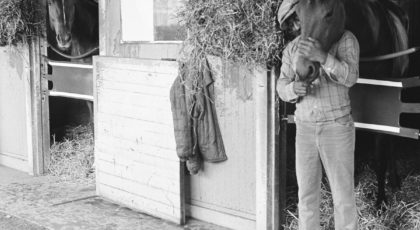The past couple of weeks have been confusing for equestrians as we try to shift our minds from “pre-purchase exam” to “personal protective equipment” every time we see PPE.
I confess, it took me longer than it should have to catch on.
But now that we’re settled into this new reality in which people are more concerned about buying face masks and gloves than Hanoverians, it’s time to get down to business and figure out how to best keep ourselves healthy.
In my last post, I mentioned that making masks is a good way to do something useful and manage anxiety during the pandemic. With the CDC considering altering their guidelines to encourage people to wear homemade masks when in public, this seems like a good time to get started. If you need to run to the barn to drop off a board check or hold your horse for the farrier, a mask might be a good idea.
Before I began this undertaking, I did some research about materials and effectiveness. Cotton seems to offer the best combination of breathability and protection, so I washed some old t-shirts and went to town.
Here are the materials I used:
- Cotton t-shirts
- Floral wire (to help the mask conform to the nose)
- Craft elastic (because it’s all my craft store had left online)
- Vacuum cleaner bags made of HEPA filtering material
- This pattern
- Sewing machine (but you could hand-sew)
- Thread
- Sharpie

Step 1: Cut the fabric according to the pattern
To cut faster, you could double the fabric and cut two at a time. I’m a conservationist at heart so I just cut individual pieces to waste less fabric. I made separate stacks of pieces for the outer pieces and inner pieces so I didn’t get the two mixed up.
Step 2: Sew two pieces for the outer part of the mask together along the curved edge

You will want the top of the curve to cover your nose.
I then hemmed the outer piece, and when I did so, I sewed the floral wire into the top of it so that it would conform to the nose. This is great for glasses wearers and also adds protection. It’s the hardest part, so take your time and give yourself plenty of seam allowance.
Repeat the process with the inner piece, attaching the pieces and hemming the top edge (but without the wire).
Step 3: Attach the pieces together

Center the inner piece inside the outer piece. I made sure that the seam sides were in so that I wouldn’t have my crudely sewn seam rubbing my nose. Sew them together along the left and right sides and the bottom, but leave the top open so you have the option to slide a filter in.
Step 4: Add the elastic
There are two ways to approach this. You can make two loops of elastic and add one to each side and then fold the sides over, stitch them down, and you’re done. If you want elastic that just goes behind each ear, this is the way to do it.

But I am a delicate flower and elastic behind my ears will bother me, so I made one much bigger elastic loop, laid it out so that I could stitch the sides down over it on each side, and now I have elastic that goes all the way around behind my head instead of just behind my ears. Much comfier, in my opinion.

Step 5: Write INSIDE on the inside of your mask with your Sharpie.
That way, if the wearer takes it off and puts it back on, they won’t put the outside against their face and breathe in everything they’d been trying to filter out.
A word on filters
There is currently no medical consensus on what is the best filter to use. I used the vacuum cleaner bags, but I will admit they are hard to breathe through.
Paper towels and wet wipes don’t appear to be effective. Those blue paper garage towels work okay, but they’re hard to find right now. Some have suggested cotton flannel as a good homemade alternative if you can’t get your hands on anything else.
A note of caution
Homemade masks are not foolproof against COVID-19, but they might help in other ways—preventing you from catching a cold, and keeping you from thoughtlessly touching your mouth or nose when out and about.
Be sure to wash your mask after every use and hang it to try in the sunlight if possible.
Remember, cotton holds moisture, which is bad, so a dirty/wet mask is probably worse than no mask at all. And if you do touch your mask, consider it contaminated and wash your hands thoroughly.
Finally, do not let having a mask of any kind lull you into a false sense of security. The most effective way to prevent the spread is to stay at home.
Stay healthy, everyone!
Jess Clawson is a freelance writer, event rider, and historian based in Berryville, Virginia.


 April 7, 2020
April 7, 2020 


























